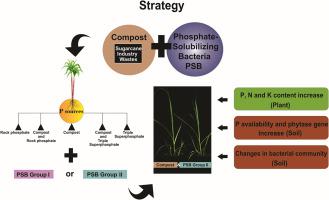当前位置:
X-MOL 学术
›
Appl. Soil Ecol.
›
论文详情
Our official English website, www.x-mol.net, welcomes your
feedback! (Note: you will need to create a separate account there.)
Use of compost and phosphate-solubilizing bacteria affect sugarcane mineral nutrition, phosphorus availability, and the soil bacterial community
Applied Soil Ecology ( IF 4.8 ) Pub Date : 2021-01-01 , DOI: 10.1016/j.apsoil.2020.103760 German A. Estrada-Bonilla , Ademir Durrer , Elke J.B.N. Cardoso
Applied Soil Ecology ( IF 4.8 ) Pub Date : 2021-01-01 , DOI: 10.1016/j.apsoil.2020.103760 German A. Estrada-Bonilla , Ademir Durrer , Elke J.B.N. Cardoso

|
Abstract The appropriate utilization of phosphorus (P) for fertilization of sugarcane is critical to reduce the economic costs and the environmental impact caused by traditional management practices. Phosphate-solubilizing bacteria (PSB) play an essential role in P cycling and in the P transfer to the plant, thus increasing crop productivity. The goal of this study was to evaluate soil P lability and plant mineral nutrition, as well as changes in the soil bacterial community upon the use of alternative P sources and inoculation with PSB. Different P sources were evaluated, including compost of sugarcane industry wastes, rock phosphate, and triple superphosphate (TSP). Additionally, we carried out soil P fractionations to study its availability. The use of compost as a P source and co-inoculation with Bacillus sp. BACBR04, Bacillus sp. BACBR06, and Rhizobium sp. RIZBR01 increased the content of P in shoot compared with the uninoculated treatments that received only compost or TSP (i.e. soluble P). This treatment also displayed an increase of nitrogen and potassium content in plant tissue. The increase in P content correlated with an increment in soil P availability, as well as with changes in the soil bacterial community and the predicted presence of the phytase gene. These results present a potential new strategy for sugarcane fertilization, using PSB in combination with compost to improve P nutrition and growth in sugarcane with reduced economic and environmental impact.
中文翻译:

堆肥和磷酸盐溶解细菌的使用影响甘蔗矿物营养、磷的有效性和土壤细菌群落
摘要 甘蔗施肥中适当利用磷(P)对于降低经济成本和传统管理方式造成的环境影响至关重要。解磷细菌 (PSB) 在磷循环和磷转移到植物中发挥重要作用,从而提高作物生产力。本研究的目的是评估土壤可塑性和植物矿物营养,以及在使用替代磷源和接种 PSB 后土壤细菌群落的变化。评估了不同的磷源,包括甘蔗工业废料的堆肥、磷酸盐岩和三重过磷酸钙 (TSP)。此外,我们进行了土壤 P 分馏以研究其可用性。使用堆肥作为磷源并与芽孢杆菌共接种。BACBR04,芽孢杆菌属。BACBR06, 和根瘤菌。与仅接受堆肥或 TSP(即可溶性磷)的未接种处理相比,RIZBR01 增加了地上部磷的含量。这种处理还显示出植物组织中氮和钾含量的增加。磷含量的增加与土壤磷有效性的增加以及土壤细菌群落的变化和植酸酶基因的预测存在相关。这些结果提出了一种潜在的甘蔗施肥新策略,将 PSB 与堆肥结合使用,以改善甘蔗的磷营养和生长,同时减少对经济和环境的影响。这种处理还显示出植物组织中氮和钾含量的增加。磷含量的增加与土壤磷有效性的增加以及土壤细菌群落的变化和植酸酶基因的预测存在相关。这些结果为甘蔗施肥提供了一种潜在的新策略,将 PSB 与堆肥结合使用,以改善甘蔗的磷营养和生长,同时减少对经济和环境的影响。这种处理还显示出植物组织中氮和钾含量的增加。磷含量的增加与土壤磷有效性的增加以及土壤细菌群落的变化和植酸酶基因的预测存在相关。这些结果为甘蔗施肥提供了一种潜在的新策略,将 PSB 与堆肥结合使用,以改善甘蔗的磷营养和生长,同时减少对经济和环境的影响。
更新日期:2021-01-01
中文翻译:

堆肥和磷酸盐溶解细菌的使用影响甘蔗矿物营养、磷的有效性和土壤细菌群落
摘要 甘蔗施肥中适当利用磷(P)对于降低经济成本和传统管理方式造成的环境影响至关重要。解磷细菌 (PSB) 在磷循环和磷转移到植物中发挥重要作用,从而提高作物生产力。本研究的目的是评估土壤可塑性和植物矿物营养,以及在使用替代磷源和接种 PSB 后土壤细菌群落的变化。评估了不同的磷源,包括甘蔗工业废料的堆肥、磷酸盐岩和三重过磷酸钙 (TSP)。此外,我们进行了土壤 P 分馏以研究其可用性。使用堆肥作为磷源并与芽孢杆菌共接种。BACBR04,芽孢杆菌属。BACBR06, 和根瘤菌。与仅接受堆肥或 TSP(即可溶性磷)的未接种处理相比,RIZBR01 增加了地上部磷的含量。这种处理还显示出植物组织中氮和钾含量的增加。磷含量的增加与土壤磷有效性的增加以及土壤细菌群落的变化和植酸酶基因的预测存在相关。这些结果提出了一种潜在的甘蔗施肥新策略,将 PSB 与堆肥结合使用,以改善甘蔗的磷营养和生长,同时减少对经济和环境的影响。这种处理还显示出植物组织中氮和钾含量的增加。磷含量的增加与土壤磷有效性的增加以及土壤细菌群落的变化和植酸酶基因的预测存在相关。这些结果为甘蔗施肥提供了一种潜在的新策略,将 PSB 与堆肥结合使用,以改善甘蔗的磷营养和生长,同时减少对经济和环境的影响。这种处理还显示出植物组织中氮和钾含量的增加。磷含量的增加与土壤磷有效性的增加以及土壤细菌群落的变化和植酸酶基因的预测存在相关。这些结果为甘蔗施肥提供了一种潜在的新策略,将 PSB 与堆肥结合使用,以改善甘蔗的磷营养和生长,同时减少对经济和环境的影响。











































 京公网安备 11010802027423号
京公网安备 11010802027423号